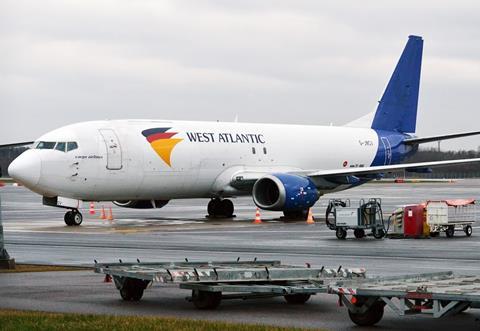UK investigators have found that a Boeing 737-400 freighter crew inadvertently used weight data from a previous flight to calculate take-off performance, resulting in a tail-strike at East Midlands.
The West Atlantic aircraft – with a crew of two, including a first officer under training – had been bound for Aberdeen on 1 December last year.
After the aircraft was de-iced, the captain was handed a sheaf of papers including the flight’s loadsheet – which the captain checked as correct – plus de-icing receipts, essential notifications about the cargo, plus a loadsheet for the same aircraft from a previous flight.
“Although not recognising this at the time, the crew used the figures from this incorrect loadsheet to calculate the take-off performance figures,” says the UK Air Accidents Investigation Branch.
The data used for the calculation included a take-off weight of just over 43t compared with the aircraft’s actual weight of 53.1t.

While each pilot used their own Boeing software tool to carry out the calculations and “trap any errors made in data entry”, says the inquiry, both were entering information from the earlier flight.
The 10t weight differential meant the performance software calculated take-off parameters for an aircraft much lighter, giving a rotation speed of 124kt – far lower than the 139kt required.
Lower speeds demanded less engine thrust, and the software also generated a stabiliser trim setting which was slightly more nose-up than it should have been. This trim would have made pitch-control forces feel lighter than expected.
As the aircraft accelerated along runway 27, the captain initiated rotation at 123kt, but the speed was insufficient. The pitch rate increased and peaked at 5°/s about 4s later and the aircraft lifted off at 137kt, with the pitch at 12.3° – exceeding the 11.4° threshold for a tail-strike.
The strike damaged the tail-skid and a drainage mast, but the crew believed the take-off had been normal, and considered whether the bump they had felt was due to a load shift.
But a check of the load, after the aircraft was established in cruise at 24,000ft, ruled out a shift and the captain decided to run tail-strike procedures as a precaution.
Given the first officer’s relative inexperience, the captain opted against diverting or depressurising the aircraft at high altitude, and instead descended to 9,000ft before depressurising and continuing to Aberdeen. The aircraft (G-JMCV) landed safely and neither pilot was injured.


























